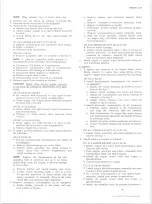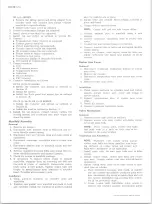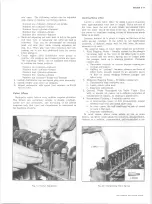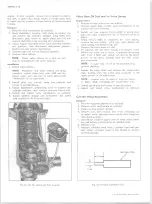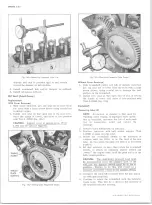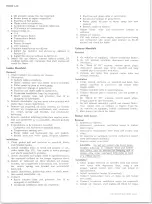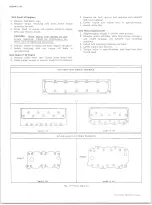
ENGINE 6-29
Valve Mechanism
Removal
1. Remove rocker arm covers as outlined.
2. Remove rocker arm nuts, rocker arm balls, rocker
arms and push rods.
NOTE:
Place rocker arms, rocker arm balls
and push rods in a rack so they may be re
installed in the same locations.
Installation and Adjustment
NOTE:
Whenever new rocker arms and/or
rocker arm balls are being installed, coat bear
ing surfaces of rocker arms and rocker arm
balls with "Molykote” or its equivalent.
1. Install push rods. Be sure push rods seat in lifter
socket.
2. Install rocker arms, rocker arm balls and rocker
arm nuts. Tighten rocker arm nuts until all lash is
eliminated.
3. Adjust valves when lifter is on base circle of cam
shaft lobe as follows:
a. Crank engine until mark on torsional damper
lines up with center or “ O " mark on the timing
tab fastened to the crankcase front cover and the
engine is in the number 1 firing position. This
may be determined by placing fingers on the
number 1 valve as the mark on the damper comes
near the “ 0 ” mark on the crankcase front cover.
If the valves are not moving, the engine is in the
number 1 firing position. If the valves move as
the mark comes up to the timing tab, the engine
is in number 6 firing position and should be
turned over one more time to reach the number
1 position.
Fig. lV -ln t a k e M a nifold Gasket and Seal Location
b. With the engine in the number 1 firing position
as determined above, the following valves may be
adjusted.
Exhaust - 1, 3, 4, 8
Intake
- 1, 2, 5, 7
c. Back out adjusting nut until lash is felt at the
push rod then turn in adjusting nut until all lash
is removed. This can be determined by checking
push rod side play while turning adjusting nut
(fig. 2V). When play has been removed, turn
adjusting nut in one full additional turn (to center
lifter plunger).
d. Crank the engine on revolution until the pointer
"O ” mark and torsional damper mark are again
in alignment. This is number 6 firing position.
With the engine in this position the following
valves may be adjusted.
Exhaust - 2, 5, 6, 7
Intake
- 3, 4, 6, 8
4. Install rocker arm covers as outlined.
5. Adjust carburetor idle speed (and mixture on 20-30
series).
Valve Lifters
Hydraulic valve lifters very seldom require attention.
The lifters are extremely simple in design, readjust
ments are not necessary, and servicing of the lifters
requires only that care and cleanliness be exercised in
the handling of parts.
Locating Noisy Lifters
Locate a noisy valve lifter by using a piece of garden
hose approximately four feet in length. Place one end
of the hose near the end of each intake and exhaust valve
with the other end of the hose to the ear. In this manner,
the sound is localized making it easy to determine which
lifter is at fault.
Another method is to place a finger on the face of the
valve spring retainer. If the lifter is not functioning
properly, a distinct shock will be felt when the valve
returns to its seat.
The general types of valve lifter noise are as follows:
1. Hard Rapping Noise--Usually caused by the plunger
becoming tight in the bore of the lifter body to such
an extent that the return spring can no longer push
the plunger back up to working position. Probable
causes are:
a. Excessive varnish or carbon deposit causing
abnormal stickiness.
b. Galling or "pick-up between plunger and bore of
lifter body, usually caused by an abrasive piece
of dirt or metal wedging between plunger .and
lifter body.
2. Moderate Rapping Noise--Probable causes are:
a. Excessively high leakdown rate.
b. Leaky check valve seat.
c. Improper adjustment.
3. General Noise Throughout the Valve Train--This
will, in almost all cases, be a definite indication of
insufficient oil supply, or improper adjustment.
4. Intermittent Clicking--Probable causes are:
a. A microscopic piece of dirt momentarily caught
between ball seat and check valve ball.
F R O N T S E A L
10-30 CHEVROLET TRUCK SERVICE MANUAL
Summary of Contents for 10 1971 Series
Page 1: ......
Page 96: ......
Page 100: ...10 30 CHEVROLET TRUCK SERVICE MANUAL Fig 4 10 30 Series Truck Frame FRAME 2 4 ...
Page 120: ......
Page 203: ...ENGINE 6 25 Fig 22L Engine Mounts 10 30 CHEVROLET TRUCK SERVICE MANUAL ...
Page 215: ...ENGINE 6 37 REAR M O U NT Fig 21V Engine Mounts 10 30 CHEVROLET TRUCK SERVICE MANUAL ...
Page 218: ......
Page 249: ......
Page 324: ......
Page 340: ......
Page 365: ...10 30 CHEVROLET TRUCK SERVICE MANUAL Fig 43 Power Steering Pump M ounting STEERING 9 25 ...
Page 368: ......
Page 386: ......
Page 390: ...ELECTRICAL BODY AND CHASSIS 12 4 10 30 CHEVROLET TRUCK SERVICE MANUAL ...
Page 391: ......
Page 428: ......
Page 432: ......
Page 449: ...SPECIFICATIONS 9 10 30 CHEVROLET TRUCK SERVICE MANUAL ...
Page 463: ......
Page 464: ......
Page 465: ......
Page 466: ......

